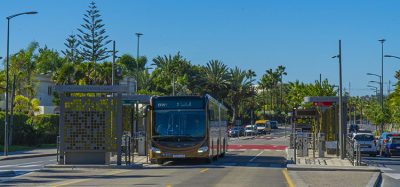BC Transit unveils details of new electronic fare collection system, Umo
- Like
- Digg
- Del
- Tumblr
- VKontakte
- Buffer
- Love This
- Odnoklassniki
- Meneame
- Blogger
- Amazon
- Yahoo Mail
- Gmail
- AOL
- Newsvine
- HackerNews
- Evernote
- MySpace
- Mail.ru
- Viadeo
- Line
- Comments
- Yummly
- SMS
- Viber
- Telegram
- Subscribe
- Skype
- Facebook Messenger
- Kakao
- LiveJournal
- Yammer
- Edgar
- Fintel
- Mix
- Instapaper
- Copy Link
Posted: 18 February 2022 | Intelligent Transport | No comments yet
Offering a more accessible and convenient way for passengers to pay for travel, BC Transit’s new electronic fare collection system, Umo, is set to be launched across British Columbia in late 2022.
British Columbia-based public transport operator BC Transit has announced exciting steps forward in its project to implement an electronic fare collection system across the province, sharing details of the coming system and releasing the brand that represents the system, Umo (pronounced ‘you-mo’).
The innovative new system will replace end-of-life technology and equipment, introducing contactless tap payment methods that will improve the transit experience for passengers. New payment methods will include a mobile app, debit card, credit card, mobile wallet and reloadable smart card, providing riders with the ability to pick the best payment method for their lifestyle and travel habits.
The new contactless payment methods will increase access to transit by allowing riders to use items that they carry every day, removing barriers like requiring them to pre-purchase tickets and passes or carry exact change.
The coming system also introduces a new stored value feature, providing riders with further abilities to select the best option for their travel needs. Riders using the mobile app and reloadable smart card will be able to load a stored value balance to their account to be drawn from as they ride, in addition to being able to purchase any of the existing fare products. Riders will be able to easily purchase their desired fare product with their mobile device, through a new web portal, or at a retailer and board the bus by simply scanning their mobile device or tapping their card. Cash will continue to be accepted for those riders who prefer to use it, but it is expected that most riders will find one of the new payment methods a more convenient option.
Other benefits of BC Transit‘s electronic fare collection system will include:
- Enabling seamless interregional transit by allowing riders to travel across the province with one payment method
- Improving onboard cleanliness by reducing farebox touchpoints with the implementation of contactless payments
- Improving service reliability by reducing the demand on transit operators to visually validate and administer fare products aboard the bus
- Increasing ridership by utilising the electronic system’s tools to administer promotions and new programmes.
The new system will be implemented in transit systems and interregional routes in two phases, initially enabling mobile app and reloadable smart card payment methods before payment by credit card, debit card and mobile wallets will be enabled. The Victoria Regional Transit System has been selected for the system’s pilot project and first transit system implementation, and can expect to see the system come on board by Autumn 2022.
Other transit systems and interregional routes scheduled for system implementation include Agassiz-Harrison, Campbell River, Central Fraser Valley, Chilliwack, Comox Valley Regional, Cowichan Valley Regional, Cowichan Valley Commuter, Cranbrook, Dawson Creek, Fort St. John, Fraser Valley Express, Hope Regional, Kamloops, Kelowna Regional, Kitimat, North Okanagan Connector, Pemberton Valley, Port Alberni Regional, Port Edward, Powell River Regional, Prince George, Prince Rupert, Quesnel, Regional District of Nanaimo, Skeena Regional, South Okanagan Connector, South Okanagan-Similkameen, Squamish, Sunshine Coast, Terrace Regional, Vernon Regional, Whistler, and West Kootenay.
The Electronic Fare Collection System Project is funded through the Investing in Canada Infrastructure Program. This project is being cost-shared, with the Government of Canada contributing 50 per cent of eligible costs, the Province of British Columbia contributing 40 per cent and the project’s local government partners contributing the remaining 10 per cent. The total cost for this project is $23,200,000.
Related topics
Accessibility, Passenger Experience, Public Transport, Ticketing & Payments
Related countries
Canada
Related organisations
BC Transit, Government of Canada, Province of British Columbia, Victoria Regional Transit System








